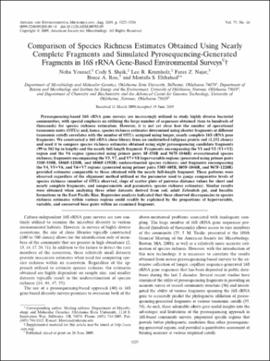| dc.contributor.author | Youssef, Noha | |
| dc.contributor.author | Sheik, Cody S. | |
| dc.contributor.author | Krumholz, Lee R. | |
| dc.contributor.author | Najar, Fares Z. | |
| dc.contributor.author | Roe, Bruce A. | |
| dc.contributor.author | Elshahed, Mostafa S. | |
| dc.date.accessioned | 2018-08-29T14:24:30Z | |
| dc.date.available | 2018-08-29T14:24:30Z | |
| dc.date.issued | 2009-08 | |
| dc.identifier | oksd_youssef_comparisonofspe_2009 | |
| dc.identifier.citation | Youssef, N., Sheik, C. S., Krumholz, L. R., Najar, F. Z., Roe, B. A., & Elshahed, M. S. (2009). Comparison of species richness estimates obtained using nearly complete fragments and simulated pyrosequencing-generated fragments in 16S rRNA gene-based environmental surveys. Applied and Environmental Microbiology, 75(16), 5227-5236. https://doi.org/10.1128/AEM.00592-09 | |
| dc.identifier.uri | https://hdl.handle.net/11244/301603 | |
| dc.description.abstract | Pyrosequencing-based 16S rRNA gene surveys are increasingly utilized to study highly diverse bacterial communities, with special emphasis on utilizing the large number of sequences obtained (tens to hundreds of thousands) for species richness estimation. However, it is not yet clear how the number of operational taxonomic units (OTUs) and, hence, species richness estimates determined using shorter fragments at different taxonomic cutoffs correlates with the number of OTUs assigned using longer, nearly complete 16S rRNA gene fragments. We constructed a 16S rRNA clone library from an undisturbed tallgrass prairie soil (1,132 clones) and used it to compare species richness estimates obtained using eight pyrosequencing candidate fragments (99 to 361 bp in length) and the nearly full-length fragment. Fragments encompassing the V1 and V2 (V1 V2) region and the V6 region (generated using primer pairs 8F-338R and 967F-1046R) overestimated species richness; fragments encompassing the V3, V7, and V7 V8 hypervariable regions (generated using primer pairs 338F-530R, 1046F-1220R, and 1046F-1392R) underestimated species richness; and fragments encompassing the V4, V5 V6, and V6 V7 regions (generated using primer pairs 530F-805R, 805F-1046R, and 967F-1220R) provided estimates comparable to those obtained with the nearly full-length fragment. These patterns were observed regardless of the alignment method utilized or the parameter used to gauge comparative levels of species richness (number of OTUs observed, slope of scatter plots of pairwise distance values for short and nearly complete fragments, and nonparametric and parametric species richness estimates). Similar results were obtained when analyzing three other datasets derived from soil, adult Zebrafish gut, and basaltic formations in the East Pacific Rise. Regression analysis indicated that these observed discrepancies in species richness estimates within various regions could readily be explained by the proportions of hypervariable, variable, and conserved base pairs within an examined fragment. | |
| dc.format | application/pdf | |
| dc.language | en_US | |
| dc.publisher | American Society for Microbiology | |
| dc.rights | This material has been previously published. In the Oklahoma State University Library's institutional repository this version is made available through the open access principles and the terms of agreement/consent between the author(s) and the publisher. The permission policy on the use, reproduction or distribution of the material falls under fair use for educational, scholarship, and research purposes. Contact Digital Resources and Discovery Services at lib-dls@okstate.edu or 405-744-9161 for further information. | |
| dc.title | Comparison of species richness estimates obtained using nearly complete fragments and simulated pyrosequencing-generated fragments in 16S rRNA gene-based environmental surveys | |
| osu.filename | oksd_youssef_comparisonofspe_2009.pdf | |
| dc.description.peerreview | Peer reviewed | |
| dc.identifier.doi | 10.1128/AEM.00592-09 | |
| dc.description.department | Microbiology and Molecular Genetics | |
| dc.type.genre | Article | |
| dc.type.material | Text | |
| dc.subject.keywords | ribosomal rna | |
| dc.subject.keywords | gene | |
